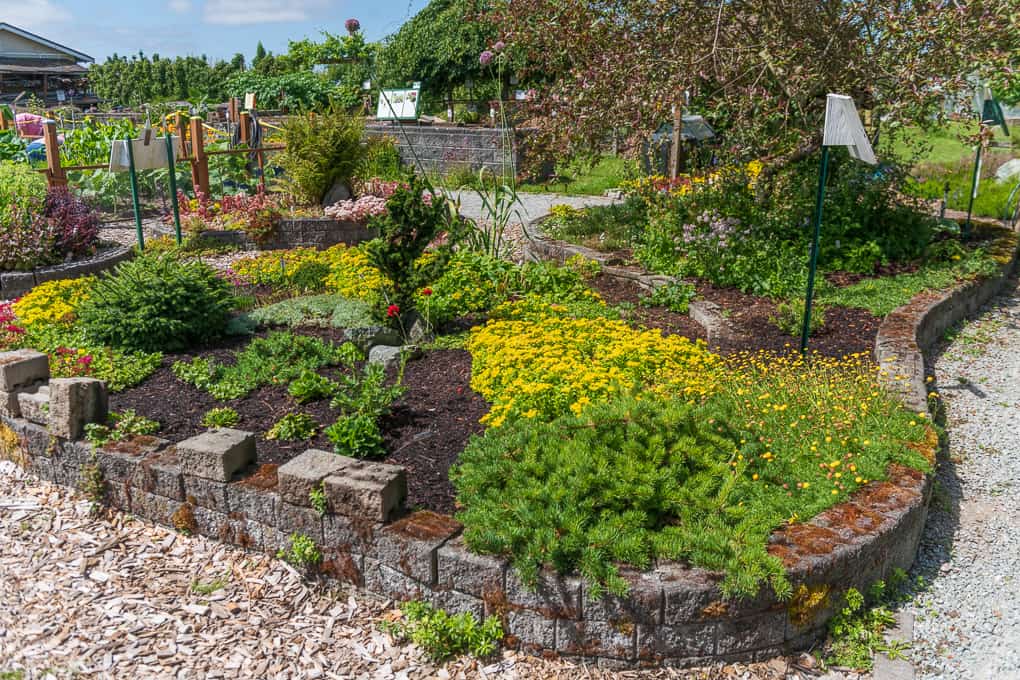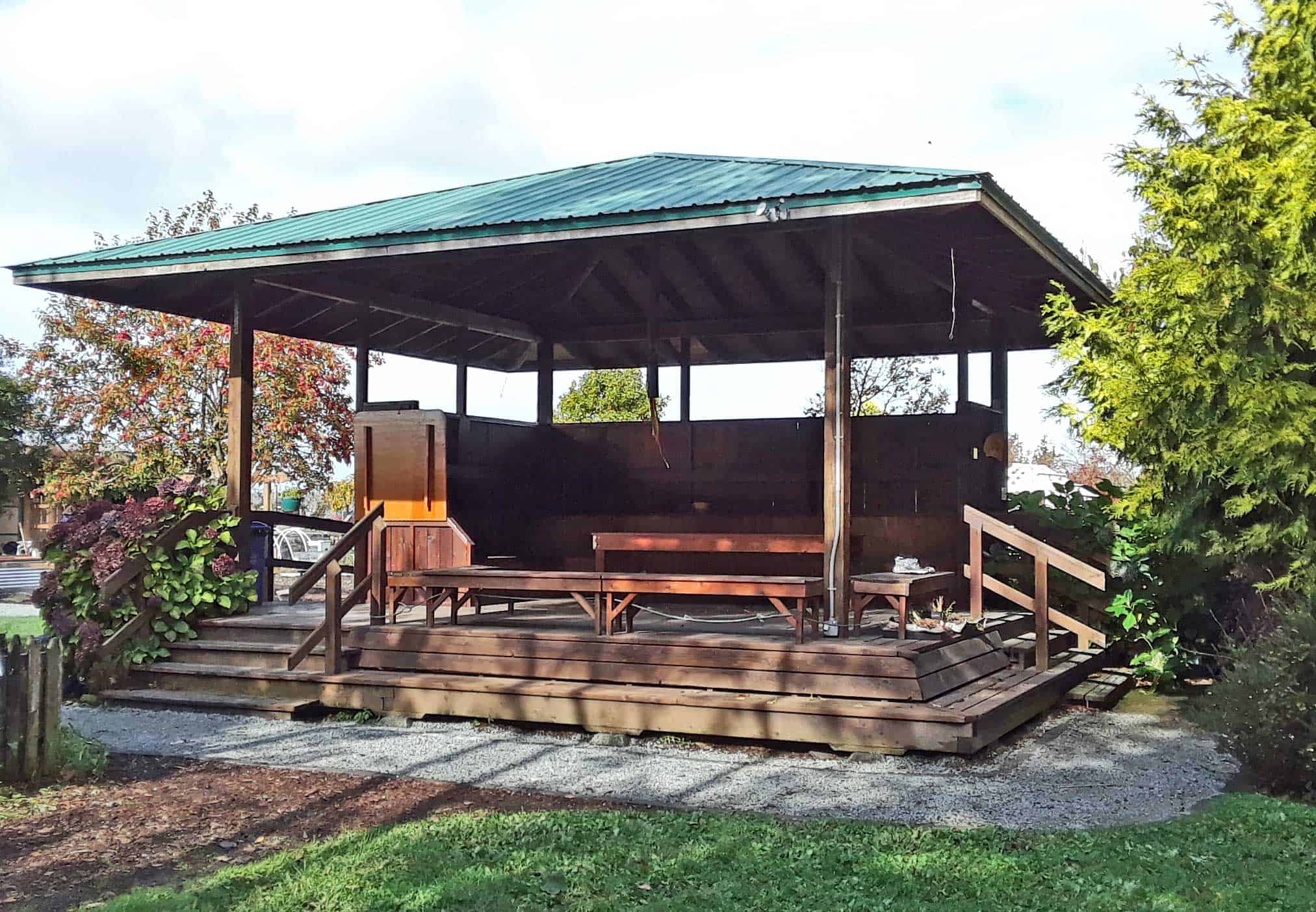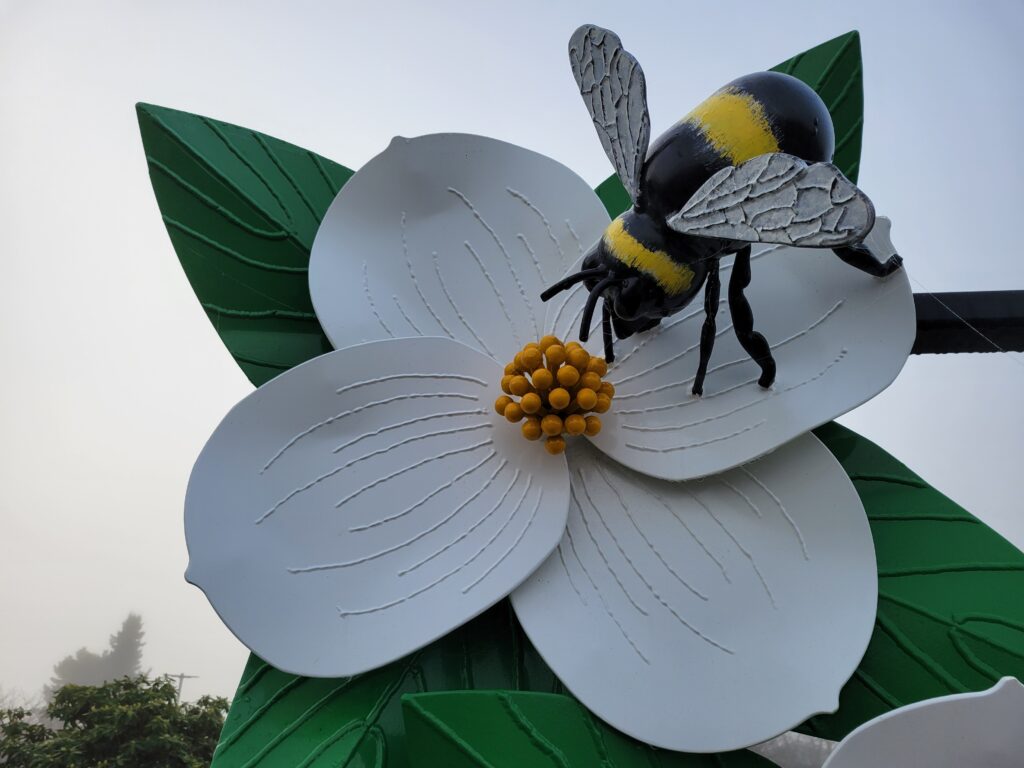Skagit County
WSU Extension
Master Gardener
Discovery Garden
Free Admission
Open to the public from dawn to dusk daily
Signage throughout the garden introduces and explains the plantings and growing techniques used. Master Gardeners work in the garden on Tuesdays and can answer your questions about the garden.
Explore our themed garden rooms and discover your personal retreat
Location
WSU Northwestern Washington Research and Extension Center
(NWREC)
16602 State Route 536
(Memorial Hwy)
Mount Vernon, WA 98273
The garden is located adjacent to the Salal Native Plant Garden and Western Washington Fruit Research Foundation orchard.
The Pavilion

Master Gardener Tuesday workday lunches are held in this sheltered gathering place. The pavilion is also used for public educational activities, seminars and workshops.
Take a Self-guided Tour
Discovery Garden Brochure (English)
Discovery Garden Brochure (Spanish)
Tree Walk
The Paths
 When you visit the Discovery Gardens, you will benefit from new Americans with Disabilities Act (ADA) accessible paths winding the way through splendid examples of Pacific Northwest gardening.
When you visit the Discovery Gardens, you will benefit from new Americans with Disabilities Act (ADA) accessible paths winding the way through splendid examples of Pacific Northwest gardening.
Our 33 Garden Rooms
Entrance Garden
 The small gardens surrounding the entrance fountain greet visitors with plants having year-round interest. Easy-care, layered plantings are chosen for the Pacific Northwest climate.
The small gardens surrounding the entrance fountain greet visitors with plants having year-round interest. Easy-care, layered plantings are chosen for the Pacific Northwest climate.
Shade Garden
 Does your garden have a “shady” personality? This garden suggests alternatives to sun-loving plants so that even a shady garden can bask in color, texture and smell.
Does your garden have a “shady” personality? This garden suggests alternatives to sun-loving plants so that even a shady garden can bask in color, texture and smell.
Cool Color Garden

Are you needing to feel cool and relaxed? This border creates a cool-feeling by including plants with texture and shades of blue, green, purple, lavender, silver and white.
Pollinator Gardens

The Pollinator Garden is planted with an assortment of both native and non-native shrubs and perennials. Plants chosen are known to be nectar and pollen sources for diversity of pollinators.
Japanese Garden

There are five distinct types of Japanese gardens: hill and pond, dry landscape, tea, courtyard, and stroll. Ours is of the stroll design. Odd numbers of plants and stones are used in groupings and spaced unevenly. Dry rock beds symbolize rushing rivers; large rocks represent mountains. Not surprisingly, water features are an integral part of Japanese gardens.
Passage Garden

This garden consists of a pathway through two long and narrow borders. The plants are pruned to accommodate the characteristics of a passageway. They include a dogwood, two hydrangeas, a “Golden Spirit’ smokebush and a smoketree, and numerous hellebores.
Four Seasons Garden

Year-round interest and minimal care are key to this diverse mixed border garden. Trees, shrubs and a fence are the backdrop for perennials, vines, and biennials punctuated by annuals and bulbs to add a pop of seasonal color. Evergreens and foundation specimens anchor the garden’s silhouette.
Fall and Winter Garden

This garden showcases fall-blooming perennials,
bright berries, and brilliant foliage giving way to bare branches and beautiful bark. Evergreen foliage, winter blooms, and early bulbs lead the way to spring.
Doc's Arbor

Created in memory of Dr. Richard “Doc” Hoag, one
of a small group of master gardeners who envisioned the Discovery Garden. He and his wife gave the first “seed” money donation. Doc grew grapes and made many different kinds of wine.
Ornamental Grasses

Many ornamental grasses are especially well-suited to thrive in Skagit County, and will add texture, movement, and interest in any landscape. Sizes, colors and shapes can fit a variety of needs and conditions.
Rose Garden

Considering a new rose for your garden? Walk
through the 40+ varieties of traditional and modern
roses blooming May through first frost.
Rhododendron Garden

Since 2007 this garden has provided a harmonious
space to view the wide variety of rhododendrons that can be grown in the Pacific Northwest climate.
Lloyd Eighme's Heather Garden

With year-round interest, heather is in bloom every
month in this garden. These varieties show growth
patterns from ground covers to tree forms.
Iris Garden

The iris plantings display different species and
their bloom cycles from late winter through summer.
Ground Covers and Dwarf Conifers

Ground covers can be used to smother weeds, fill in areas under trees, stabilize hillsides, soften the edges of pathways, and reduce evaporation. Here Master Gardeners have showcased commonly available shade and sun-tolerant plants and dwarf conifers.
Succulent Garden

Succulents are drought tolerant and easy to propagate. Available in a wide variety of textures,
shapes, sizes, and colors, they are low-maintenance, requiring well-drained soil and full sun for optimal growth. See the many that are hardy in this area.
DIG-IT! Discovery In the Garden Is Terrific

Magic happens here! Throughout the growing season, the sorted and chipped prunings, browns, and greens are combined and turned. Mother Nature does her part, giving us nutrient-rich compost in a few months.
Composting Area

Magic happens here! Throughout the growing season, the sorted and chipped prunings, browns and greens are combined and turned. Mother Nature does her part and gives us nutrient-rich compost in a year.
Small Fruits

Multiple types of berries, currants, and small fruits
are grown here. See Heritage and Cascade Delight raspberries, low-bush blueberries, lingonberries, strawberries, boysenberries, evergreen huckleberries, and Triple Crown thornless blackberries.
Cottage Garden

This somewhat whimsical garden dates back to the 1300s when space was limited around each home. Ornamental and edible varieties were commonly planted together to maximize every available inch.
Hardy Fuchsia Garden

Originally planted by members of the North Cascade Fuchsia Society, all the varieties in this garden are hardy enough to survive Skagit County winters. Even in the shade of the pavilion, the garden blooms in beautiful colors from early summer until frost.
Vegetable Garden

The garden features a no-till garden demonstrating
raised borderless beds in addition to those constructed of wood and/or metal. Here, favorite older and newer varieties are selected to grow well in our Northwest maritime climate. Educational and inspirational, this garden emphasizes the importance of soil health, trellis styles, and crop rotation.
Herb Garden

Skagit Valley’s climate is perfect for herbs. The classic English herb garden structure, history, and purpose have been interpreted for Northwest living. Different hedging materials surround the formal design creating a garden room with themed gardens planted within.
Children's Garden

Parents and children share the pleasure of Children’s Garden. Enter through a mulberry arch and find a perfect place to play hide-and-seek. Here, kids of all ages can play games, make music, or captain a boat. Enjoy a snack at the picnic table and find ideas to take home.
Perennial Plant House

Home to perennials and plants propagated throughout the year for the annual Plant Fair in May.
Greenhouse

The greenhouse is busy in late winter through spring as Master Gardeners start seeds and take cuttings for new plants that are used in the garden or sold at the Plant Fair held the Saturday before Mother’s Day in May.
Meadow

Designed as an open area with year-round interest, the Meadow is a low-maintenance, large space incorporating ornamental grasses, native plants, and a wildlife snag to create visual interest in this natural space.
Naturescape

This informal garden room features meandering footpaths bordered by native and non-native plantings. Stroll the paths and contemplate the variety of eco- systems represented by the sunny meadow, the pond, and the shady corner. Find inspiration for your personal green space isolated from adjacent buildings and traffic.
Enabling Garden

The six raised beds and ergonomic tool display illustrate ways to garden for those with limited strength, energy, and physical ability. Scented, colorful, textured plants are featured in the raised beds, some of which offer sitting ledges.
Joe's Place

The large anchor at the entrance is in memory of
Navy veteran, Joe Dupré, an early graduate of the
program. Some of Joe’s favorite plantings reside here, including primroses, fuchsias, fig tree, and ferns.
The Pavilion

This sheltered gathering place is used for master gardener lunches, educational activities, seminars, and workshops. Reserve the space through our website.
WWI Elm Tree Memorial

Fifty elms are planted along Memorial Highway
honoring the men from Skagit County who died in
WWI. Granite plaques placed by each tree name each of the fifty men lost. Each May, Master Gardeners have a ceremony to commemorate their sacrifice.
Front Door Garden

Located in the center of the gravel parking lot at the entry to the Discovery Garden, this garden welcomes visitors with a large metal sculpture, featuring three Pacific Dogwood blossoms and a bee.
Our Garden
The Discovery Garden is maintained by Skagit County WSU Extension Master Gardener volunteers as a demonstration garden for the public. Our vision is to:
- Interest, inspire and educate the public
- Develop a garden for community use and enjoyment
- Enhance the quality of the environment of Skagit County
History
In 1994, the WSU Skagit County Master Gardeners had a vision for a Demonstration Garden. It took two years to plan the garden, then in the fall of 1996, the first structure trees and fences were established. Over the following two years, with the help of many committed WSU Master Gardeners and the community, the garden was planted.
One of the garden founders, Julie Hubner, said that having people with ideas and letting them run was the most important part of designing. She said having people, encouraging people to make decisions, allowing people to make decisions, and loving people who make those decisions were essential to a project. In the beginning there were 15 people working the vision of the WSU Skagit County Master Gardener Demonstration Garden - The Discovery Garden. From a blank 1.5 acre field, 13 garden rooms were carved out. Now there are over 30 garden rooms.












